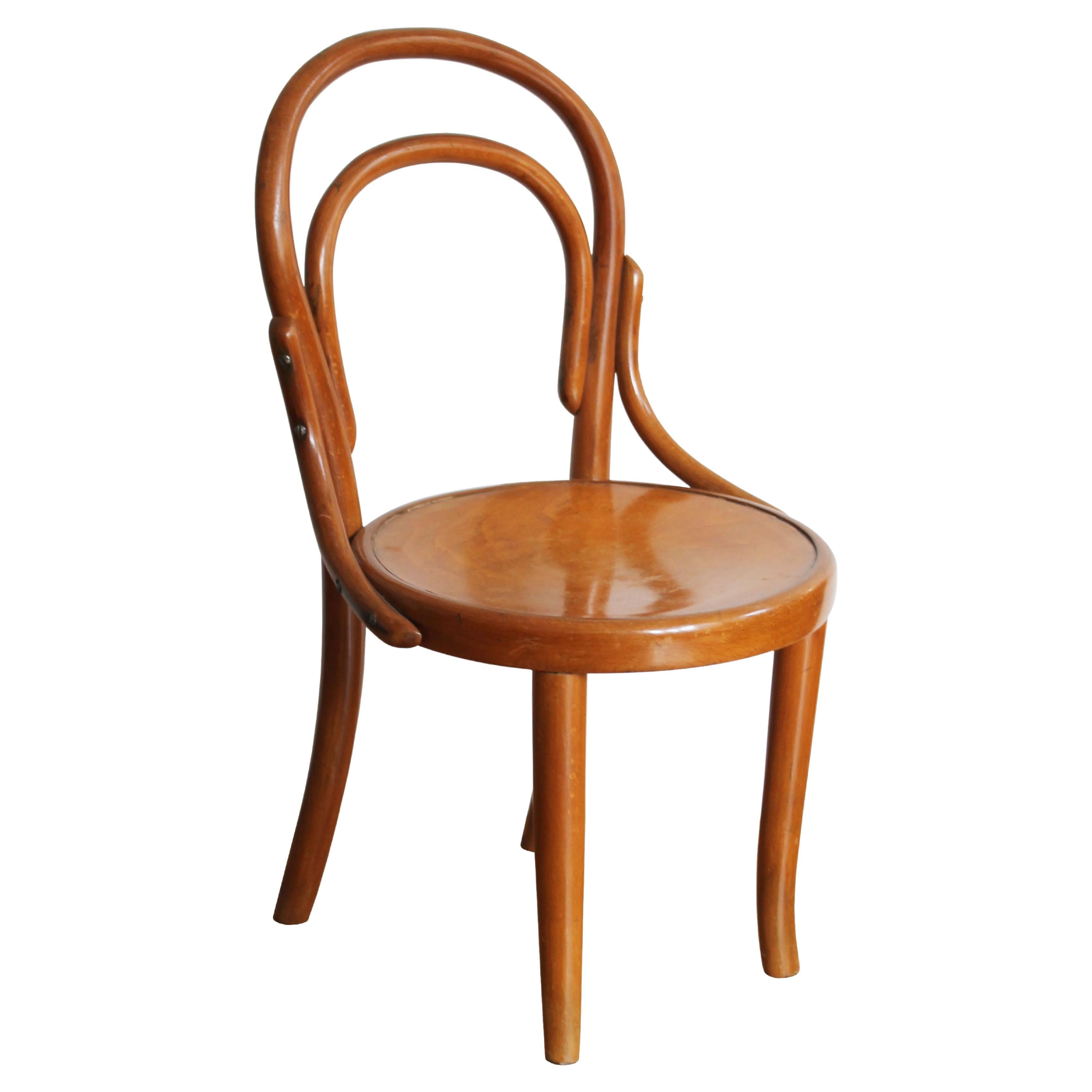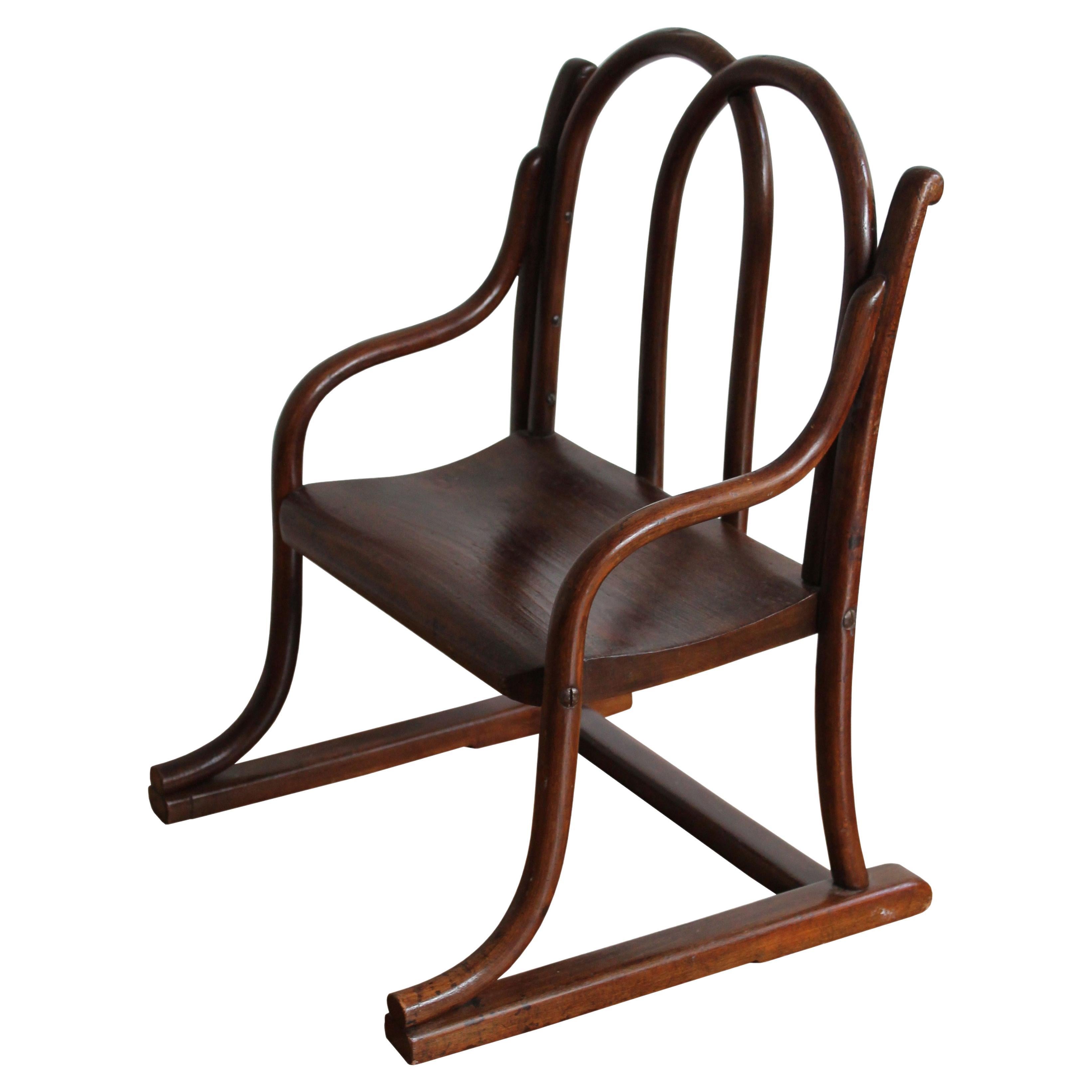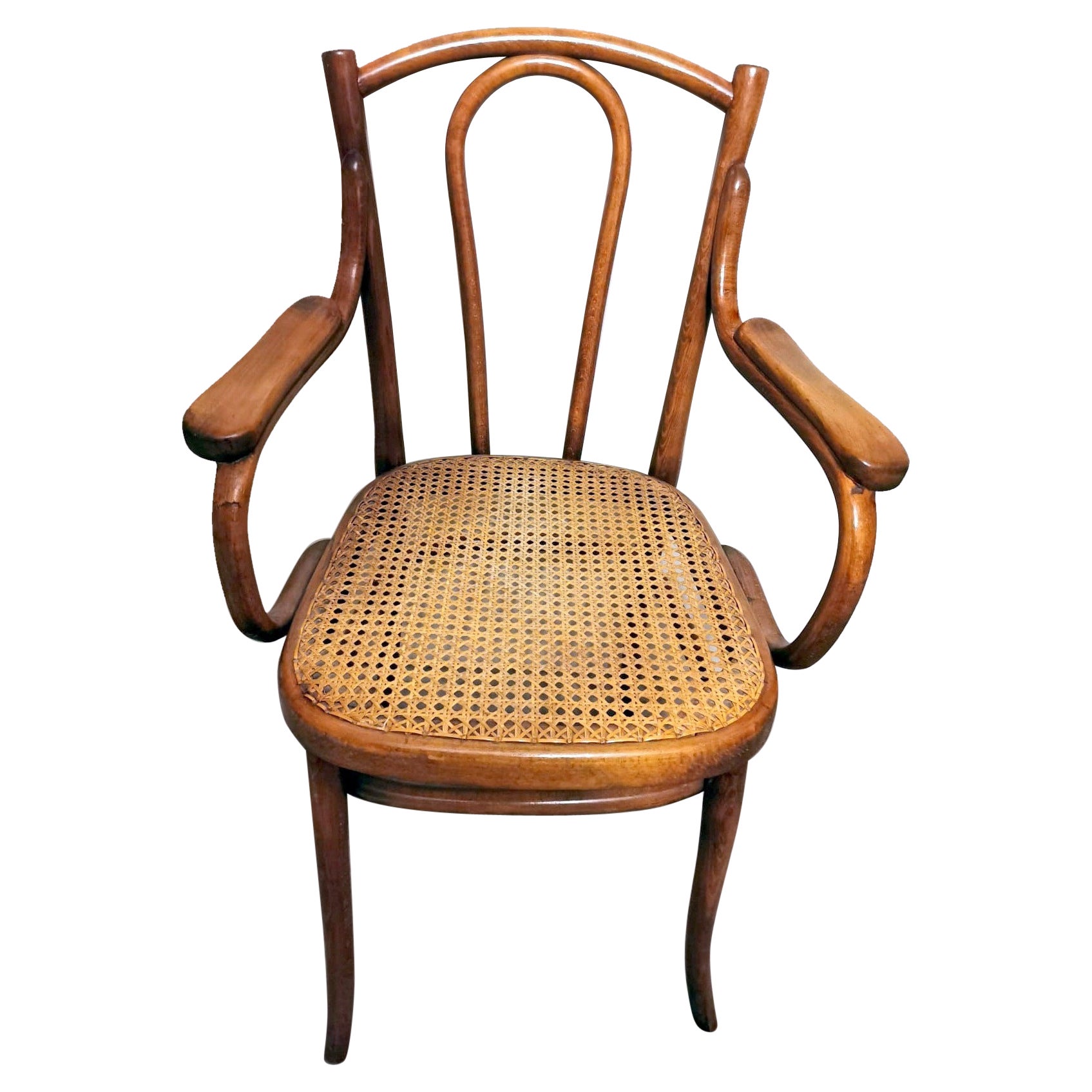Items Similar to 1920's Office chair Model No.3 by Gebrüder Thonet
Want more images or videos?
Request additional images or videos from the seller
1 of 21
1920's Office chair Model No.3 by Gebrüder Thonet
About the Item
This office/dinning chair was originally designed at the second half of the 19th century, and can be found in the Thonet sales catalogues as model number 3. This particular piece is believed to be produced by the Thonet company in the 1920’s.
The design of this chair is similar to model No. 13 and No. 23, but this one was designed without any additional supports between the seat and the backrest. The round seat with the slender circular support and the gentle arc of the legs and armrests are both a trademark of Thonet’s design in the end of 19th and early 20th century. The subtle decoration in shape of a star in the seat is the main decor and gives this model that bit of an extra quality. Thonet offered quite a scale of different decorations for the seats or backrests where possible.
These type of chairs were very popular not only for their comfort, but they were also often used by architects in offices or restaurants all around the world. We believe this is due to the essence of their design fitting perfectly into any interior - whether modern or traditional.
- Creator:Gebrüder Thonet Vienna GmbH (Manufacturer)
- Dimensions:Height: 31.89 in (81 cm)Width: 24.81 in (63 cm)Depth: 21.66 in (55 cm)Seat Height: 1.97 in (5 cm)
- Style:Art Deco (In the Style Of)
- Materials and Techniques:Beech,Varnished
- Place of Origin:
- Period:
- Date of Manufacture:Circa 1920
- Condition:Refinished. Wear consistent with age and use. This chair is in great vintage condition, with some minimal wear and patina on the surface gained from its use over the years. The piece is structurally fine without any damage to the construction.860.
- Seller Location:Brno, CZ
- Reference Number:1stDibs: LU6290238652412
About the Seller
No Reviews Yet
Vetted Seller
These experienced sellers undergo a comprehensive evaluation by our team of in-house experts.
1stDibs seller since 2022
Typical response time: 4 hours
- ShippingRetrieving quote...Ships From: Brno, Czech Republic
- Return PolicyA return for this item may be initiated within 2 days of delivery.
More From This SellerView All
- 1920's Children Chair Model No.1 by Gebrüder ThonetBy August Thonet, Gebrüder Thonet Vienna GmbHLocated in Brno, CZAn authentic bentwood kid's chair made at the beginning of the 20th century by the Thonet Furniture company - and known as Chair Model Number 1. Thonet has a great tradition of produ...Category
Vintage 1920s Austrian Art Nouveau Chairs
MaterialsBeech, Bentwood
- 1920's Dining Chair Model No. 105 by Gebrüder ThonetBy Gebrüder Thonet Vienna GmbH, Michael ThonetLocated in Brno, CZThis is one of the most commercially successful chairs designed and produced by famous Gebrüder Thonet Company. It was first designed in 1885 (most likely by August Thonet) and can b...Category
Vintage 1910s Czech Art Nouveau Chairs
MaterialsBeech
- 1910's Children chair by Gebrüder ThonetBy Gebrüder Thonet Vienna GmbHLocated in Brno, CZAn authentic bentwood kids chair made at the beginning of the 20th century. Originally this chair was connected to a small desk as one piece. Thonet was producing this type of kid’s furniture...Category
Vintage 1910s Austrian Art Nouveau Chairs
MaterialsBeech, Bentwood
- 1890's Thonet Dining Chair Model No.10By Gebrüder Thonet Vienna GmbHLocated in Brno, CZA rare bentwood dining chair with beautiful patterned wood and weaved rattan seat. This piece was designed and made by Gebrüder Thonet around 1850. We can find the chair in the old T...Category
Antique 1890s Austrian Belle Époque Chairs
MaterialsRattan, Beech
- Pair of 1910's dining chairs model no.221 by Gebrüder ThonetBy Gebrüder Thonet Vienna GmbH, August ThonetLocated in Brno, CZThese two dining chairs were originally designed by the Gebüder Thonet company in 1898, and could be found in Thonet sales catalogues as model number 221. These particular pieces are...Category
Vintage 1910s Austrian Art Nouveau Dining Room Chairs
MaterialsBeech, Bentwood
- Art Nouveau Three-Legged Chair Model No.81 by Gebrüder ThonetBy Gebrüder Thonet Vienna GmbHLocated in Brno, CZThis rare Thonet Art Nouveau tripod chair was designed in 1904, and in the Thonet catalogue of 1906 (see image below) it is depicted as "Schreibfauteuil Nr. 81", which translates as ...Category
Vintage 1910s Austrian Art Nouveau Armchairs
MaterialsBeech, Bentwood
You May Also Like
- Gebrüder Thonet Folding Chair No.1, circa 1867By Gebrüder Thonet Vienna GmbHLocated in Praha, CZManufactured in Austria by the Gebrüder Thonet company. First view of the chair is in the sales catalog from 1867. Newly reupholstered and finished with shellac.Category
Antique Late 18th Century Austrian Art Nouveau Armchairs
MaterialsUpholstery, Wood, Fabric
- Original Otto Prutscher by Gebrüder Thonet Chair, 1908By Woka Lamps, Gebrüder Thonet Vienna GmbH, Otto PrutscherLocated in Vienna, ATAn extremely rare Thonet chair, designed by Otto Prutscher for a Villa in Jägerndorf - Literatur: Innendekoration 1917 - Measure: Seat height 50cm.Category
Early 20th Century Austrian Jugendstil Chairs
MaterialsBentwood
- Thonet Gebruder Vienna Gmbh No.56 Bentwood and Vienna Straw ChairBy Gebrüder Thonet Vienna GmbHLocated in Prato, TuscanyWe kindly suggest you read the whole description, because with it we try to give you detailed technical and historical information to guarantee the authenticity of our objects. For t...Category
Early 20th Century Austrian Biedermeier Chairs
MaterialsBeech
- Gebrüder Thonet Vienna GmbH Hot Upholstered ChairBy Gebrüder Thonet Vienna GmbHLocated in Brooklyn, NYChromed steel structure and shell in beech plywood with or without solid wood arms. Wood or upholstered seat for chairs or armchairs. The upholstered cover is available only in the front part of the seat and back with the exposed wood edge. They can be equipped with a coupling system that allows for alignment. Additional Info: Materials: Beech wood, chromed steel, and upholstery Dimensions: H 31.9 x W 20.7 x D 20.8 inch Seat height: 17.7 inch WIENER GTV DESIGN is a trademark which distinguishes the historical and contemporary collection of Gebrüder Thonet Vienna GmbH...Category
21st Century and Contemporary Austrian Modern Chairs
MaterialsSteel
- Gebrüder Thonet Vienna GmbH Hot Chair in BeechBy Adolf Loos, Gebrüder Thonet Vienna GmbHLocated in Brooklyn, NYChromed steel structure and shell in beech plywood with or without solid wood arms. Wood or upholstered seat for chairs or armchairs. The upholstered cover is available only in the front part of the seat and back with the exposed wood edge. They can be equipped with a coupling system that allows for alignment. Additional Info: Materials: Beech wood, chromed steel Dimensions: H 31.9 x W 20.7 x D 20.8 inch Seat height: 17.7 inch WIENER GTV DESIGN is a trademark which distinguishes the historical and contemporary collection of Gebrüder Thonet Vienna GmbH...Category
21st Century and Contemporary Austrian Modern Chairs
MaterialsSteel
- Gebrüder Thonet Vienna GmbH Solden Chair in OrangeBy Gebrüder Thonet Vienna GmbHLocated in Brooklyn, NYThe continuous investigation into the long tradition of bent wood has led Gebrüder Thonet Vienna to the development of the Sölden chair, a new design that pays homage to the stylistic codes typical of the ‘30s, an important chapter in the tradition of bent wood that still needs more research. For the first time, Gebrüder Thonet Vienna in fact shift the focus from the 1800s to the ‘30s of last century, a particularly intense period under architectural and artistic side which has seen its success in Art Decò, known in Vienna as Jugendstil.Sölden is, therefore, a chair where bent wood takes on a more contemporary character thanks to the square section and shapes that echo the typical clean design of the Bauhaus period. Peculiarities are the large square upholstered seat and the woven cane backrest, that just like a large fan with a bent-wooden frame, welcomes the back, ensuring great comfort. Realization of the pay off “Heritage designs the future”, chosen by Gebrüder Thonet Vienna for some years to tell the deep bond with the past, Sölden reveals in its traditional spirit a contemporary personality, perfect for refined contract projects. Additional Info: Materials: Beech wood, upholstery. Dimensions: H 33 x W 19.2 x D 20.8 inch Seat height: 17.7 inch WIENER GTV DESIGN is a trademark which distinguishes the historical and contemporary collection of Gebrüder Thonet Vienna GmbH...Category
21st Century and Contemporary Austrian Modern Chairs
MaterialsWood
Recently Viewed
View AllMore Ways To Browse
Harp Chair Attributed To Jorgen Hovelskov
Henry Massonet
Jacobean With Carved Faces
Jd01 Noir
Kastholm Skater
Katy Dining Chair
Kjer Jakobsen
Laverne Lotus Chair
Light And Dwell Frankie Wave Scalloped Counter Stool
Luciano Frigerio Sedie
Lukki Chair
Mammamia Diamond Aluminum
Marc Newson Coast
Marina Zalszupin
Mario Botta 91
Mario Prandina
Mart Stam Canrilever Chairs
Metal Schoolhouse Chairs





